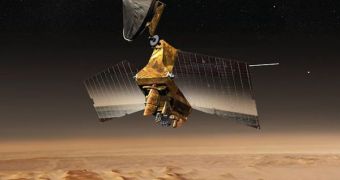Early on Monday, NASA's Mars Reconnaissance Orbiter suffered an unexpected glitch and was forced to reboot its primary computer system and enter safe mode, mission scientists announced late on Wednesday. The malfunction means that further scientific observations are impossible until the problem is found and fixed. The extent of the damage has not yet been assessed, but experts say that they expect to have a full diagnostic within a matter of days. This is the fifth glitch the craft has met since its 2005 launch date, but it's different from all the earlier ones, NASA has revealed.
MRO is still in safe mode, pending the full results of the analysis. According to the team, the craft might have experienced a surge in its electricity consumption, although that hasn't yet been fully verified. But if such a surge did occur, it might have been real, as in the batteries experiencing fluctuations, or a phantom reading, or even the result of a cosmic ray hitting the spacecraft, while it was orbiting behind the Red Planet, as seen from the Earth.
“We are going to bring the spacecraft back to normal operations, but we are going to do so in a cautious way, treating this national treasure carefully. The process will take at least a few days,” Jim Erickson, the project manager for the MRO mission from NASA's Jet Propulsion Laboratory, in Pasadena, California, says.
At this point, officials have not elaborated on what may have caused the glitch, but sources argue that if, indeed, a surge has been responsible for the issue, it may have lasted anywhere between 200 nanoseconds and 41 seconds. If a cosmic ray hit the MRO, then a power surge as short as nine microseconds would have been enough to prompt the reboot and shut down all the instruments aboard the spacecraft.
The good news is that the Orbiter is otherwise in perfect state, NASA has informed. Its batteries are fully charged, and the high-tech solar panels it uses to harness the power of the Sun are working flawlessly. On Monday, engineers boosted the craft's transmission array, so that it would work approximately 10,000 faster than usual. This has allowed them to get a better view of what is going on, and to restore a part of the computer systems on the probe, although others are still off-line.

 14 DAY TRIAL //
14 DAY TRIAL //